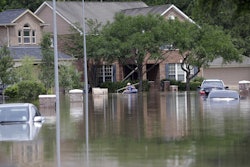SPOKANE, Wash. (AP) — A second giant tank containing radioactive waste from the production of plutonium for nuclear weapons may be leaking on the sprawling Hanford Nuclear Reservation in Washington state.
The U.S. Department of Energy this week revealed that air monitors attached to an aging tank known as AY-101 recently showed radiation at higher than normal background levels.
While a video inspection of the million-gallon underground tank found no evidence of a leak, Hanford officials said they cannot rule a leak out.
"There is a potential there is something that you can't see that is causing the change," said Tom Fletcher, manager of Hanford's tanks.
Scientists are investigating other possible causes, such as cross-contamination of the ventilation system. There also is a possibility that the contamination has been there for a long time and was recently found by chance, Fletcher said.
A Hanford watchdog group on Tuesday contended the radiation found by the air monitors was conclusive evidence of a leak, and proved that replacement tanks must be built to replace the 40-year-old originals.
WHAT IS HANFORD?
The 500-square mile Hanford reservation was established near Richland, Washington, by the Manhattan Project during World War II to make plutonium, a key ingredient in nuclear weapons. Hanford made the plutonium for the atomic bomb that was dropped on Nagasaki, Japan, and much of the plutonium for the nation's nuclear arsenal.
The 177 underground tanks at Hanford store more than 56 million gallons of some of the most toxic radioactive waste known to man..
WALLS MATTER
Of the 177 tanks, 149 are older single-walled structures, some dating back to World War II. Some are leaking and all are past their engineered lifespan. There are 28 newer double-walled tanks, which hold up to a million gallons each, and they are considered much safer and more stable. But earlier this month, the oldest of those double-walled tanks was found to be leaking, and now a second is suspected of leaking.
IS THE LEAK A THREAT TO HUMANS?
No radioactive waste has leaked into the environment from the double-walled tanks. Instead, waste has leaked from the primary tank into the space between the two walls, which is called the annulus. The Department of Energy has said it presents no danger to humans or the environment if it does not escape the outer shell.
WHAT CAN BE DONE?
Short-term, the waste can be pumped from the annulus back into the primary tank. Long-term, the government needs to either finish a long-delayed plant to treat the wastes, or build new tanks to hold the wastes. The Energy Department has resisted building expensive new tanks, saying it does not need them. But the partially-built Waste Treatment Plant at Hanford has been delayed by design and safety concerns.
WHAT DOES THIS ALL COST?
The latest estimate to finish the cleanup of Hanford is $107.7 billion and the work will take until 2060. The Energy Department in recent years has spent about $2 billion a year on cleanup work. The work is a major driver of the economy of the Tri-Cities of Richland, Kennewick and Pasco.






















